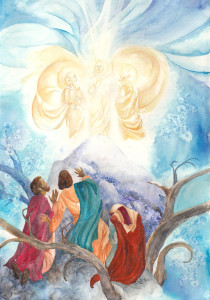The Transfiguration or Our Lord
The Lord be with you
 Tomorrow is Transfiguration Sunday. On our calendar, Transfiguration Sunday always falls on the Last Sunday after the Epiphany. The Epiphany season can have up to nine Sundays (counting Transfiguration Sunday) and as few as five (again counting Transfiguration). The length of the Epiphany season is determined by the beginning of Lent, which in turn is determined by how early Easter is. As Ash Wednesday can be as early as February 4 and as late as March 10 Transfiguration Sunday can be as early as February 1 and as late as March 7. This means that the first week in February is the earliest Transfiguration Sunday can fall, and it is in the first week that we have this Festival this year.
Tomorrow is Transfiguration Sunday. On our calendar, Transfiguration Sunday always falls on the Last Sunday after the Epiphany. The Epiphany season can have up to nine Sundays (counting Transfiguration Sunday) and as few as five (again counting Transfiguration). The length of the Epiphany season is determined by the beginning of Lent, which in turn is determined by how early Easter is. As Ash Wednesday can be as early as February 4 and as late as March 10 Transfiguration Sunday can be as early as February 1 and as late as March 7. This means that the first week in February is the earliest Transfiguration Sunday can fall, and it is in the first week that we have this Festival this year.
Lutherans are actually the ones who moved Transfiguration Sunday to the Last Sunday after the Epiphany. Methodists now follow this dating. Other denominations observe the day on different dates, though their propers for the day still share the Epiphany theme. Roman Catholics, for example, use the Transfiguration on the Second Sunday in Lent. Eastern Orthodox churches often use August 6.
This festival commemorates the moment on the Mount of Transfiguration when three of Jesus’ disciples glimpsed their Lord in divine splendor, seeing Him as the center of the Law (Moses) and the Prophets (Elijah). Jesus proclaimed to His disciples, then and now, that He was the long-awaited one who had come to die for the sins of the world and be raised again in glory.
This mountaintop glimpse of the glorified Christ is just what we need before we enter into the Lenten valley of repentance. It not only provides us with the assurance of the Resurrection of Christ, but also the assurance of our resurrection on the Last Day. Though we are sinners, Christ wins the victory over sin and death and grants that victory to all who believe in him.
Blessings in Christ,
Pastor John Rickert
